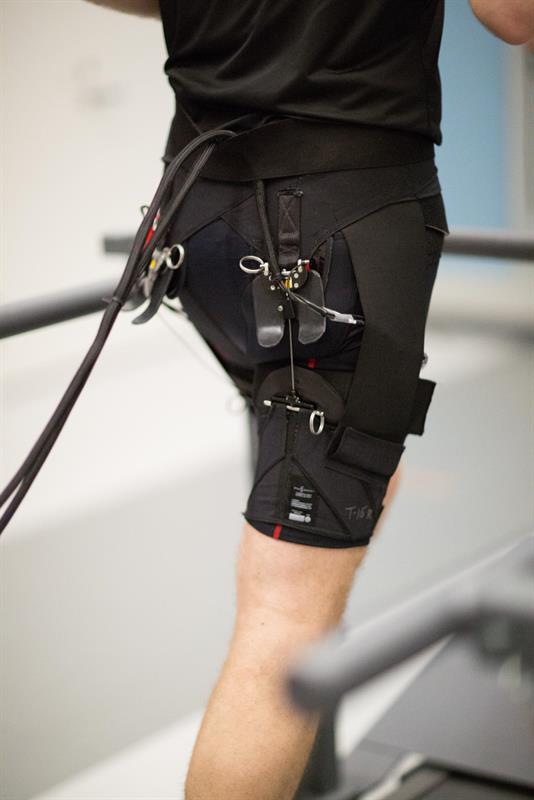“Homo sapiens has evolved to become very good at distance running, but our results show that further improvements to this already extremely efficient system are possible,” said Philippe Malcolm, formerly of the Wyss Institute and SEAS, and now assistant professor at the University of Nebraska, Omaha, where he continues to collaborate on this work.
A team of scientists at the Wyss Institute lab, led by postdoctoral fellow Giuk Lee, performed the study with an exosuit that incorporated flexible wires connecting apparel anchored to the back of the thigh and waist belt to an external actuation unit. As subjects ran on a treadmill wearing the exosuit, the actuation unit pulled on the wires, which acted as a second pair of hip extensor muscles applying force to the legs with each stride. The metabolic cost was measured by analysing the subjects' oxygen consumption and carbon dioxide production while running.
 The team tested two different ‘assistance profiles’, or patterns of wire-pulling: one based on human biology that applied force starting at the point of maximum hip extension observed in normal running, and one based on a simulation of exoskeleton-assisted running that applied force slightly later in the running stride and suggested that the optimal point to provide assistive force might not be the same as the biological norm. Confirming this suspicion, Lee and his team found that the simulation-based profile outperformed the biology-based profile in reducing metabolic cost by about a factor of two.
The team tested two different ‘assistance profiles’, or patterns of wire-pulling: one based on human biology that applied force starting at the point of maximum hip extension observed in normal running, and one based on a simulation of exoskeleton-assisted running that applied force slightly later in the running stride and suggested that the optimal point to provide assistive force might not be the same as the biological norm. Confirming this suspicion, Lee and his team found that the simulation-based profile outperformed the biology-based profile in reducing metabolic cost by about a factor of two.
To clarify why applying force later in running stride improved metabolic expenditure so dramatically, the team analysed what was happening to the subjects' other joints when their hip joints were being assisted by the actuating wires. They found that the simulation-based profile also affected knee extension and the forces between the foot and the ground, while the biology-based profile did not.
“The biological profile only takes into account the amount of torque in the hip joint, but the human body is not a series of independently acting parts - it's full of muscles that act on multiple joints to coordinate movement,” explained Lee. “Applying force to the hip affects the whole body-system, and we need to consider that in order to give the best assistance.”
The team hopes to continue this research to reduce the metabolic cost of running even more by testing more actuation profiles. Lee added: “Our goal is to develop a portable system with a high power-to-weight ratio so that the benefit of using the suit greatly offsets the cost of wearing it. We believe this technology could augment the performance of recreational athletes and/or help with recovery after injury.”
The days of a battery-powered exosuit for high-performance runners are still far off, as the actuator unit - including motors, electronics, and power supply - in this study was off-board, but the researchers say technology is moving toward making an untethered assistive exosuit possible in the future.





